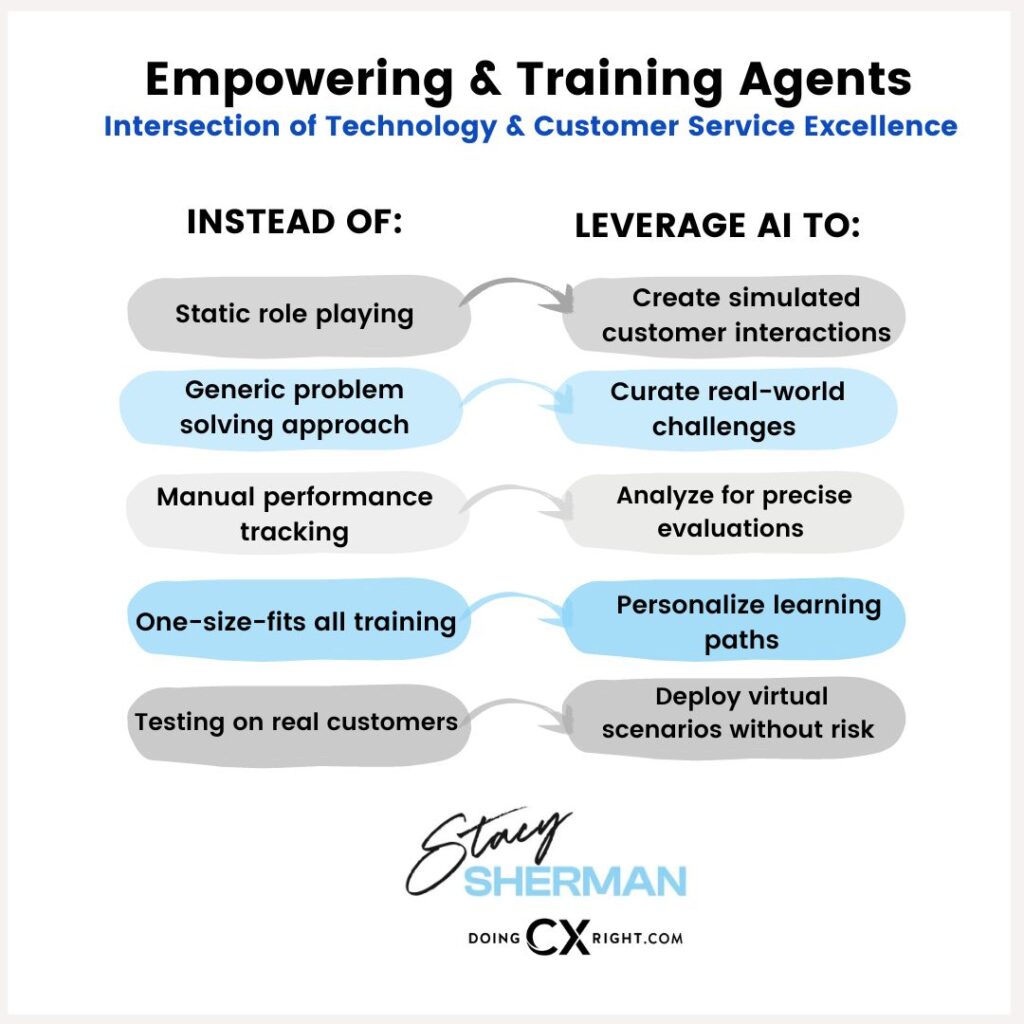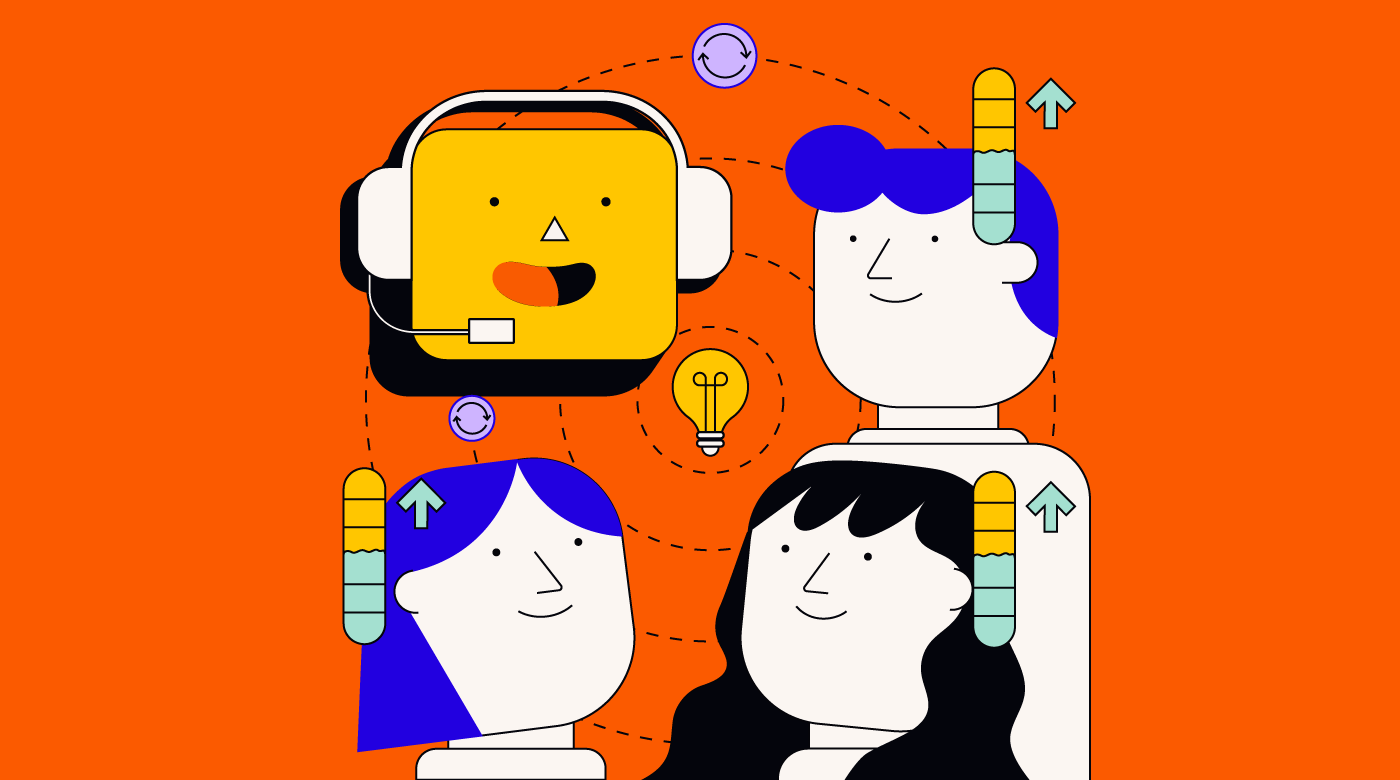In today's hyper-competitive business environment, customer experience (CX) is a pivotal differentiator. It's not just about the product or the price anymore; it's about the entire experience a brand provides. Central to this experience is customer service. A single negative interaction can leave a lasting scar on a brand's image, while consistently positive engagements can cultivate loyalty, drive repeat business, and transform customers into brand champions.
To deliver the best possible service for your customers, you need to provide the best possible experience for agents who deliver customer excellence. McKinsey research explains:

Let’s dig deeper.
Picture Sarah, a new hire at a busy customer contact center. On day one, she's inundated with training manuals, role-playing sessions, and a quick introduction to the software tools she'll be using. By week's end, she feels overwhelmed. The training seems out of touch with the real-world scenarios she faces daily. She fumbles, errs, and confronts upset customers. The imminent dread of failing to meet expectations is evident.
Sarah's story is far from unique. It mirrors the challenges countless agents deal with in the fast-paced realm of customer service. Conventional training methods frequently miss the mark, leaving agents feeling ill-equipped and unhappy.
The Challenges of Training and Retaining Customer Service Agents: How AI Comes To The Rescue
Customer service agents are the unsung heroes of many businesses. While sales teams are traditionally viewed as the frontline, it's often the customer service agents who have more frequent and prolonged interactions with customers’ post-purchase. They are the brand's voice during times of crisis, its empathetic ear during feedback, and often the difference between a one-time customer and a lifelong advocate.
However, the challenges they face are multifaceted, complex, and often underestimated:
- Frontline Pressure: Unlike sales teams who primarily focus on acquisition, customer service agents deal with the entire spectrum of customer emotions. From delighted customers praising a product to frustrated ones on the verge of brand abandonment, agents must navigate these waters tactfully and patiently. Each interaction can be a potential minefield, where one misstep can escalate a situation or tarnish the brand's reputation.
- High Attrition Rates: The emotional weight of handling many customer emotions, the pressure of targets, inadequate training, and sometimes, the lack of growth opportunities leads to burnout and high turnover. And, the constant churn is costly for companies. According to McKinsey, “Failure to retain these talented employees can have significant repercussions: employee attrition can erode customer satisfaction while increasing operating costs. Each new agent hire is estimated to cost the contact center $10,000 to $20,000 in training, direct recruiting costs, and lost productivity during ramp up in terms of recruitment and training expenses and affects the continuity of service quality and team morale.”
- Gap Between Training and Real-world Scenarios: Traditional training methods, such as classroom sessions and role-playing, often fall short of capturing the unpredictability of real-world customer interactions. They might not cover the vast array of issues agents face, from technical product glitches to customers undergoing personal crises seeking an understanding voice.
- Evolving Customer Expectations: Today's customers are more informed, more connected, and consequently, more demanding. They seek instant gratification, personalized interactions, and 24/7 availability. Keeping agents trained and updated to meet these ever-evolving expectations is a relentless task, requiring continuous curriculum updates and skill enhancement sessions.
- Keeping Up with Technological Advancements: The digital age has created an overload of communication channels – from emails to chats, social media DMs, to video calls. Agents must be proficient across these platforms, ensuring service quality and brand voice consistency. Training them on each, ensuring they're updated on new features or tools, and maintaining a uniform brand presence across channels adds complexity to the training process.
- Cultural and Linguistic Nuances: With many contact centers serving global customers, agents often must be aware of cultural, linguistic, and regional nuances. A phrase considered polite in one culture might be deemed inappropriate in another. Training agents to be culturally sensitive while ensuring they adhere to brand guidelines is a delicate balancing act.
- Lack of Real-time Support: Agents, particularly the newer ones, might require on-the-spot assistance or guidance during challenging interactions. Traditional training methods don't offer this in real-time, leaving agents to rely on their limited experience or intuition.
In light of these challenges, the power of AI in customer service training becomes even more apparent. AI doesn't just offer automation; it provides a holistic elevation of the learning and development process. It can make training more aligned with real-world scenarios, adaptive to individual agent needs, and proactive in offering timely support and feedback. In essence, AI can transform these challenges into opportunities for growth, efficiency, and enhanced customer satisfaction. It’s a win-win-win scenario for agents, their managers and ultimately customers who pay the bills.
Benefits of AI Training For Agents
- Continuous Learning: AI-powered platforms extend real-time feedback, enabling agents to learn and adjust their approach to delivering customer excellence. Unlike traditional training that might be periodic, AI-driven training is ongoing, ensuring that agents are constantly evolving and improving their skills.
- Confidence Building: Practicing within a risk-free AI environment empowers agents to experiment, err, and learn without the repercussions of real-world consequences. This builds their confidence and ensures they are more resilient in actual customer interactions.
- Adaptive Training Modules: AI can analyze an agent's performance and identify areas of weakness. Based on this analysis, it can customize training modules to address these specific gaps, ensuring that training is always relevant and targeted.
- Skill Enhancement: Beyond handling customer queries, AI-driven training can also enhance soft skills like empathy, patience, and active listening. These are crucial for building rapport with customers and ensuring positive interactions.
- Instant Access to Information: AI-driven platforms can integrate with knowledge bases, ensuring agents can access what they need during training sessions. This ot only aids in learning but also mimics real-world scenarios where agents might need to get data or product details quickly.
- Peer Learning Opportunities: Some advanced AI platforms offer features where agents can watch and learn from simulations of their peers, fostering a collaborative learning environment and promoting best practices.
Incorporating AI into agent training transforms the entire learning experience. It ensures that agents are not just trained but are empowered, confident, and equipped with a diverse skill set to handle the multifaceted challenges of customer service.
Benefits of AI Training For Managers
- Data-driven Insights: AI simulations give managers granular data on each agent's performance, spotlighting strengths and improvement opportunities. A data-driven approach ensures managers can make informed decisions, track progress over time, and identify patterns indicative of broader training needs or related issues.
- Tailored Training Modules: Leveraging insights from AI, managers can personalize training modules to cater to specific requirements. Instead of a one-size-fits-all approach, training can be tailored to individual agent needs, ensuring more effective learning outcomes and better resource utilization.
- Efficient Onboarding: AI expedites the onboarding process, ensuring agents are ready to handle real-world scenarios promptly. With AI-driven simulations and adaptive learning modules, new agents can reach proficiency faster, reducing the time and costs associated with traditional onboarding processes.
- Proactive Issue Identification: Before problems escalate or manifest in real-world customer interactions, AI can help managers identify potential problem areas, such as agent performance, knowledge gaps, or training module effectiveness.
- Performance Benchmarking: AI allows managers to set benchmarks based on top-performing agents, which not only sets a standard for excellence but also aids in recognizing and rewarding top talent.
- Resource Allocation: With insights into which agents excel in specific areas, managers can allocate resources more effectively, ensuring that the right agents handle the right kind of customer queries.
Benefits of AI Training For Customer Experience
- Consistent Service Quality: Agents trained via AI help ensure that customers receive a top-tier service. Consistency ensures that every customer interaction reinforces brand values and meets the expected service standards.
- Reduced Wait Times: Proficient agents translate to customers securing quicker resolutions. With AI-trained agents more adept at diagnosing and resolving issues, customers spend less time in queues or on hold, leading to a more efficient and satisfying service experience.
- Building Trust: Repeated positive interactions, underpinned by AI training, solidify customer trust and loyalty. When customers know they can expect high-quality service every time they interact with a brand, it fosters long-term commitment and advocacy.
- Personalized Interactions: AI can give agents insights into customer history, preferences, and potential needs, enabling agents to offer more personalized service, anticipating customer needs, and offering solutions even before a customer articulates them.
- Feedback Loop: AI-driven platforms can also gather customer feedback post-interaction, ensuring that the voice of the customer is always heard and integrated into continuous service improvement. Read more about how to make “voice of customer” your game changer.
In the evolving landscape of customer service, the integration of AI offers a transformative approach to training and service delivery. For managers, it provides the tools to optimize team performance, and for customers, it promises an experience that is efficient, consistent, and deeply satisfying.
The Role Of SaaS Companies In Enhancing Customer Experience (CX)
In this digital era, SaaS (Software as a Service) enterprises are spearheading the transformation of the customer experience landscape. They're shaping streamlined, user-centric solutions that deliver unmatched customer service and redefining industry benchmarks.
A standout SaaS company making significant strides in customer service training is Vistio. Their flagship product, ServiceSim, is a testament to the power of AI in revolutionizing agent training.
ServiceSim is not just any training tool; it's an AI-enabled simulated customer designed to immerse agents in real-life situations, replicating the intricacies and unpredictability of human conversations. It bridges the divide between traditional classroom training and actual on-the-floor interactions. Plus, it equips agents to handle many customer service challenges described earlier. The AI solution offers a safe environment for agents to practice and hone their skills without the risk of impacting real customers or the brand's reputation. Training managers benefit, and customers ultimately do, as they are interconnected.
Charting The Future: AI, SaaS, And Superior CX
As we look ahead, the synergy between AI and innovative SaaS companies like Vistio is already revolutionizing customer interactions. By harnessing AI's cutting-edge capabilities and the deep insights of human agents, businesses are creating a future where technology amplifies human touchpoints.
This transformation isn't a distant dream; its positive impacts are felt today, reshaping how companies engage with their clientele. Embracing this technology-centric approach elevates customer interactions and combats the industry's high turnover rates by instilling loyalty and job satisfaction among agents. In a competitive landscape where customer loyalty is paramount, integrating such technology is no longer optional—it's essential.

Want to continue your own training? Then click here to subscribe to our CX newsletter, then head on over here to listen to a podcast about other benefits of better agent training.


